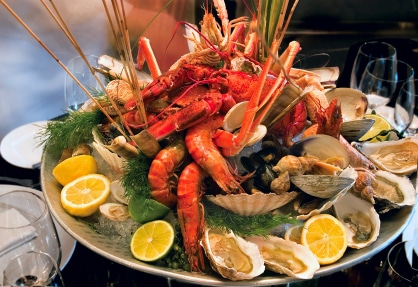Is Seafood Safe To Eat If You Have Gout?
In this post we will closely examine if seafood like lobster, shrimp, crab, clams, oysters, mussels, scallops are a healthy choice for a gout diet. As always, let’s talk a little history beforehand. In the 1800s lobster was known as poor man’s food and during that time and before seafood was shunned upon and people were embarrassed to eat it.
Poor families, servants, children and prisoners usually ate seafood due to its high abundance and easy accessibility for those who lived on the eastern coast like the states of Maine, New Hampshire and Massachusetts. The wealthier people were able to afford healthier meats like cattle and beef but seafood like lobster were seen by the poor as a cheap way to feed hungry mouths, they even had nicknames like “Poor Man’s Chicken” and “Scavengers of the Sea”.
It is actually a scavenger because it lives on the bottom of the ocean and eats the waste, yes the poop of other animals even the pollutants that man dumps into the ocean, hence why lobster is also nicknamed “the Cockroach of the Ocean”. By the late 1800s the industry was thriving and seafood hit the mainstream where it was being served at the fanciest restaurants. Today lobster is one of the most expensive items on the menu and the perception is that seafood is high quality and nutritious food!
What is the evidence that seafood is to be avoided in a gout diet?
The 12 year study completed by the American College of Rheumatology which observed 47,000 men over that period had provided these men with a questionnaire to record their daily food intake. Data from the study discovered that men who ate the most meat had 1.41 times the risk of developing gout then those men who ate the least amount of meat.
Likewise, men who ate seafood had a 1.51 times the risk of developing gout compared to those men who ate the least amount of seafood and seafood does increase your uric acid levels. That’s a 51% increased risk my fellow gout sufferer! Each additional weekly serving of seafood led to a 7% increased risk. On a side-note, the same study concluded that vegetables high in purines like peas, beans, cauliflower and spinach did not increase the risk of getting a gout attack. That is spot on, you can eat all the vegetables you like even the ones that are high on the purines scale but we will look at this more closely at a future post.
Other risks of seafood consumption
Seafood is a simply a dangerous food to eat for so many valid reasons and should be avoided at all costs. It is simply one of the dirtiest foods you can eat and can cause you so many different ailments. I mean the reason lobster is cooked while alive is due to the bacterial problem which takes place immediately upon their death needing to release astaxanthin for it to be safe for you to consume.
Shrimp is a scavenger that thrives off of eating the flesh of dead creatures, so if you like to eat shrimp be aware that you are eating feces as well. You like shellfish? Watch out cause you can be poisoned a bacterial or viral contamination. You must adequately cook it to make sure you don’t get sick but is it really worth the risk? Poisoning can also come about from heat-stable toxins derived from the food that the shellfish have been eating. If you suffer from gout, just cross out any type of seafood, I hope to help you avoid any gout flares or triggers for an attack.
Reasons to avoid Shellfish
- Shellfish can’t expel waste efficiently:
Shellfish have a simplified digestive system that makes it difficult for them to expel their waste products efficiently. This is why it’s so critical to devein a shrimp before eating it so you can remove the sand, debris, and other waste substances.Not only that, but shellfish are increasingly being contaminated by tiny plastic particles that shed off from nets, buoys, and ropes and onto the seafloor. These tiny bits of plastic are known as microplastics and can move through wastewater and into the ocean, where they may be consumed by animals.
Microplastics can build up in animals that later become food for humans as a result of this. According to a study at the University of Ghent in Belgium, researchers found that seafood eaters consume up to 11,000 microscopic fragments of plastic each year.
- The Omega-3 illusion:
Essential fatty acids are needed by our cell membranes, brain, and nervous system. Blood pressure, blood coagulation, and immunological and inflammatory responses are all aided by them. In our bodies, fatty acids are converted to the longer-chain omega-3s EPA and DHA. Omega-3 oils are typically touted as being very beneficial in the treatment of gout.They lower blood cholesterol and suppress eicosanoids, which cause clots and inflammation. In addition to helping promote a healthy cardiovascular system, omega-3s also provide benefits for our bones and joints.
Oily fish have them as well, which they get from algae. Because conversion rates in the body can be low, some people believe that fish oils are essential for good health.
They’re labeled as being ‘essential’ since humans can’t create them ourselves and must obtain them from food.
However, according to several research, fatty fish and fish oil supplements, in particular, can have the opposite impact of what is stated. In fact, the same studies suggested that these essential fatty acids may actuallly raise the risk of cardiovascular events.
- Mercury is rising:
Mercury, a naturally occurring heavy metal in rock, is primarily released into the environment through human processes such as the combustion of fossil fuels. Mercury enters our waterways and accumulates in the marine food chain. Small fish and shellfish used to be regarded as being low in mercury, while big, long-lived predator fish like king mackerel, marlin, orange roughy, shark, swordfish, ahi (or yellowfin) tuna, and bigeye tuna accumulate the most mercury.However, shellfish are now considered to have excessive levels of mercury. Mercury levels in tuna are 10 million times higher than in seawater, according to MIT researchers, and human activities since the Industrial Revolution are to blame.
Of course, humans are a part of that food chain as well. We ingest the mercury that has accumulated in those large, long-lived predator fish when we eat them.
Over time, regular consumption of mercury can potentially lead to serious health problems like damaged organs, cardiovascular disease, and neurological damage to developing kids.
- Cholesterol and Saturated Fat:
It’s vital to keep in mind that fish oils and oily fish are not the same thing. According to a study by John Mcdougall, fish is rich in cholesterol. Compared to other meats, many types of fish measured pretty high with a base of 100 grams.Protein-rich fish like sardines and roe also contribute to increasing your uric acid levels, which is a byproduct of protein metabolism and the cause of gout.Shellfish, in particular, are known for their high cholesterol levels. A single serving of shrimp includes more than half of the daily cholesterol allowance. Crabs contain about 565 milligrams of sulfur and are also high in purines, with about 175.4 milligrams of uric acid.
- Norovirus and other illnesses:
Filter-feeding shellfish, such as mussels and oysters, can accumulate bacteria and viruses from their environment, posing a direct health risk when eaten raw. In addition to increasing the risk of contracting foodborne illnesses like E. Coli and Hepatitis E, you can also catch Norovirus. Norovirus is a common cause of food poisoning that can induce fever, nausea, vomiting, cramps, and diarrhea.Because it is more common in the winter, it is also known as the winter vomiting bug, though it can be caught at any time of year.
Norovirus infections are easily transmitted from person to person or by contacting surfaces that have been infected with the virus and then touching your mouth.
Many outbreaks have been related to shellfish that have been contaminated by human feces. Norovirus contamination of bivalve shellfish, particularly oysters, has been identified as a food safety concern.
Hepatitis E, on the other hand, is widespread in many underdeveloped nations, where it is transmitted by feces and the mouth. Because of greater infrastructure, water supply, and cleanliness, outbreaks are generally infrequent in developed countries.
Pigs, for example, can serve as reservoirs. Pig unit effluent and dung have been discovered to contain high quantities. This emphasizes the risk of it entering waterways and subsequently accumulating in shellfish.
Animal excrement, sewage water, improperly treated water, contaminated seafood, and animal foods have all been shown to contain the infectious hepatitis E virus.
It is abundantly clear that shellfish and excrement seem to make frequent contact. Needless to say, that fact alone should raise a big enough red flag!
- Shellfish and allergies:
Shellfish is one of the most prevalent foods to cause allergies, and sensitivity to them is widespread over the world. Although most significant food allergies start in childhood, one in particular stands out: shellfish allergies. An allergy to shellfish can appear at any point in a person’s life, but it is most common in maturity. It can be triggered by meals that you’ve never had any problems with previously.Shellfish allergies are the most prevalent adult-onset food allergies, along with fish allergies. According to a recent survey, more than 6.5 million persons in the United States have allergies to one or both of these foods.
In other aspects, a shellfish allergy is distinct from other allergies. Allergies to shellfish, for example, might strike at any moment after a person has consumed the allergen and displayed no other symptoms.
Allergic reactions to shellfish can worsen with each exposure. To make matters worse, there is no cure for shellfish allergies. Avoiding foods like shrimp, lobster, crab, and other crustaceans is the best treatment.
Although finned fish and shellfish are unrelated, cross-contamination is common. If you have a severe shellfish allergy, you may wish to avoid seafood entirely.

